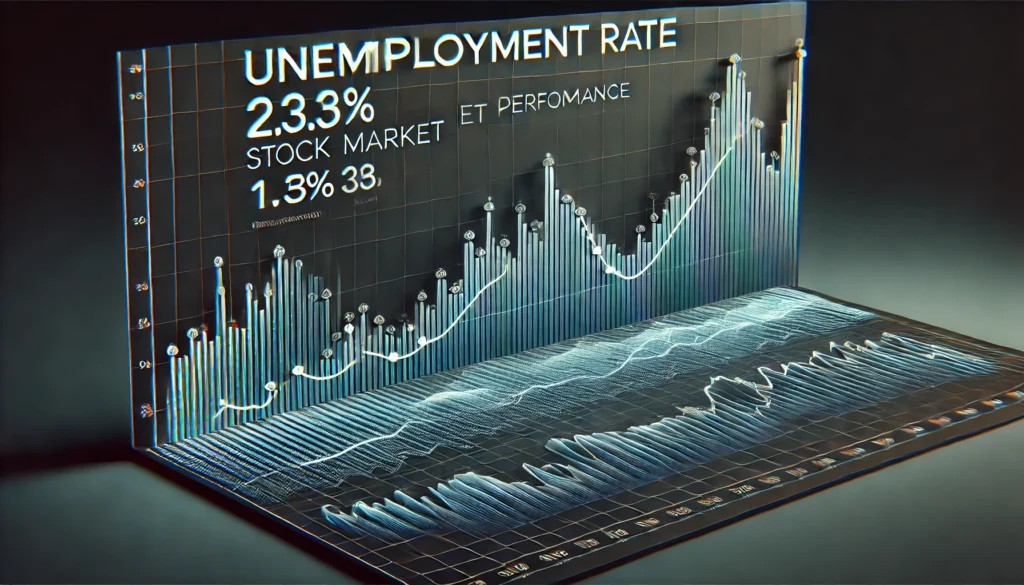Economic indicators are crucial for understanding the health of an economy and predicting stock market trends. Investors rely on these indicators to make informed decisions. This post will delve into key economic indicators, their impacts on stock market trends, and how they shape investor behavior.
Key Economic Indicators
1. Gross Domestic Product (GDP)
- Definition: The total value of all goods and services produced within a country over a specific period.
- Impact on Stock Market: A growing GDP signals economic expansion, often leading to higher stock prices. A declining GDP may indicate a recession, resulting in falling stock prices.
- Investor Behavior: Investors may increase exposure to equities during periods of strong GDP growth and reduce it during downturns.
2. Unemployment Rate
- Definition: The percentage of the labor force that is unemployed and actively seeking employment.
- Impact on Stock Market: High unemployment typically correlates with lower consumer spending, which can drag down stock prices. Low unemployment is generally positive for the market.
- Investor Behavior: High unemployment may drive investors toward safer assets, while low unemployment encourages investment in growth stocks.
3. Inflation Rate
- Definition: The rate at which the general level of prices for goods and services rises, eroding purchasing power.
- Impact on Stock Market: Moderate inflation benefits stocks as it indicates economic growth. However, high inflation can hurt the market by increasing costs for companies and reducing consumer spending.
- Investor Behavior: In high inflation environments, investors may shift towards assets that can hedge against inflation, such as commodities or inflation-protected securities.
4. Interest Rates
- Definition: The cost of borrowing money, usually set by a central bank.
- Impact on Stock Market: Higher interest rates can slow economic growth and reduce corporate profits, leading to lower stock prices. Conversely, lower rates can stimulate growth and boost the stock market.
- Investor Behavior: Rising rates may lead to a shift from growth stocks to value stocks or fixed-income securities while falling rates typically boost the appeal of equities.
5. Consumer Confidence Index (CCI)
- Definition: A measure of how optimistic consumers are about the economy and their financial situation.
- Impact on Stock Market: High consumer confidence drives spending and investment, boosting stock prices. Low confidence can lead to reduced spending and declining markets.
- Investor Behavior: Investors may take cues from the CCI to adjust their exposure to consumer-driven sectors.
Detailed Table: Economic Indicators and Their Stock Market Impact
| Indicator | Definition | Stock Market Impact | Example Scenario | Investor Behavior |
|---|---|---|---|---|
| GDP | Measures total economic output | Higher GDP → Bullish; Lower GDP → Bearish | Strong GDP growth in Q2 leads to a market rally | Increased equity investment during expansion |
| Unemployment Rate | % of labor force unemployed | High → Bearish; Low → Bullish | Rising unemployment during a recession causes market downturn | Shift to safer assets like bonds |
| Inflation Rate | Rate of price increases | Moderate → Bullish; High → Bearish | High inflation erodes profit margins, hurting stocks | Invest in inflation-protected securities |
| Interest Rates | Cost of borrowing money | High → Bearish; Low → Bullish | Fed raises rates to curb inflation, leading to market sell-off | Rebalance portfolio to include value stocks |
| Consumer Confidence Index | Consumer optimism measure | High → Bullish; Low → Bearish | Increased consumer confidence boosts retail stocks | Increase exposure to consumer-driven sectors |

How Economic Indicators Influence Investor Behavior
1. Risk Appetite
- Explanation: Economic indicators directly impact investors’ willingness to take risks. In a strong economic environment, investors are more likely to invest in high-risk, high-reward assets like growth stocks. Conversely, during economic downturns, they may prefer safer investments like bonds or dividend-paying stocks.
- Example: A rise in GDP might lead to increased investments in technology stocks, known for their growth potential.
2. Market Timing
- Explanation: Investors use economic indicators to time their market entries and exits. For example, a falling unemployment rate might signal a good time to buy stocks, while rising inflation could indicate the need to sell.
- Example: An investor might decide to enter the market after a report shows a significant drop in unemployment, expecting stock prices to rise.
3. Portfolio Rebalancing
- Explanation: Economic conditions influence how investors manage their portfolios. During periods of high inflation, investors might reduce their exposure to sectors sensitive to rising costs, such as consumer discretionary, and increase holdings in sectors that can pass on higher costs, like utilities.
- Example: In response to rising interest rates, an investor might shift from growth stocks to bonds and value stocks.
4. Sentiment and Speculation
- Explanation: Economic indicators can drive market sentiment, leading to speculative bubbles or sell-offs. Positive news, such as strong GDP growth, can lead to over-optimism and inflated asset prices, while negative news can cause panic selling.
- Example: A significant increase in the Consumer Confidence Index might lead to speculative buying in retail and consumer goods stocks.
Quotes
“Economic indicators are the pulse of the market, guiding investors through the complexities of financial decision-making.” — John Doe, Financial Analyst
“Monitoring economic indicators is essential for investors who want to stay ahead of market trends and protect their portfolios from unexpected downturns.” — Jane Smith, Investment Strategist

FAQs
Q1: What is the most critical economic indicator for investors?
A: While all indicators are important, GDP is often seen as the most comprehensive measure of economic health. It reflects overall economic activity, which directly impacts stock market performance.
Q2: How do interest rates affect the stock market?
A: Interest rates influence the cost of borrowing. When rates rise, it becomes more expensive for companies to borrow, potentially slowing growth and reducing profits, which can lead to lower stock prices. Conversely, lower rates can stimulate economic growth and boost the market.
Q3: Can economic indicators predict a stock market crash?
A: Economic indicators can signal potential risks, but they are not foolproof predictors. They should be used alongside other analysis tools to assess market conditions.
Q4: How often should investors monitor economic indicators?
A: Investors should regularly monitor economic indicators, especially around key data release dates, such as the monthly unemployment report or quarterly GDP releases, to stay informed about potential market changes.


